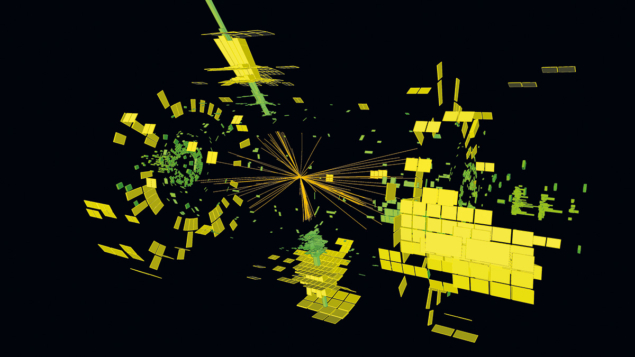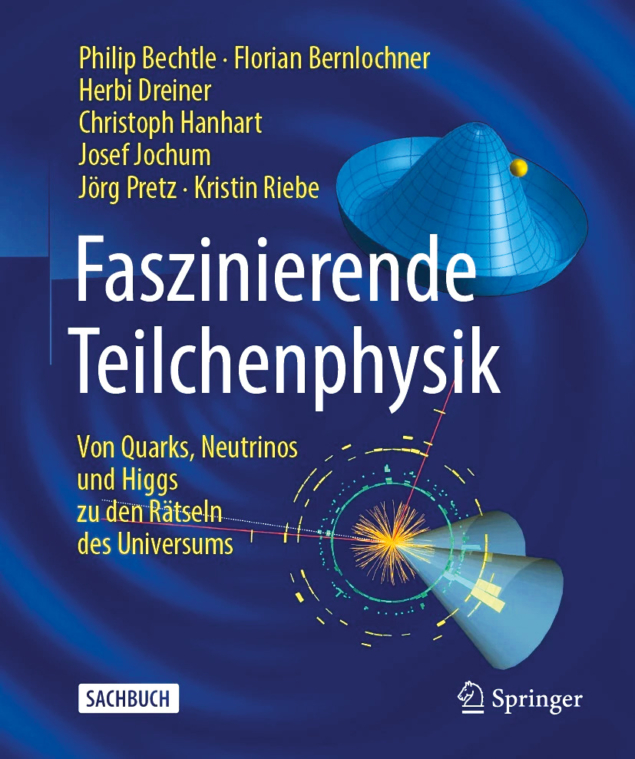Faszinierende Teilchenphysik Von Quarks, Neutrinos und Higgs zu den Rätseln des Universums, by Philip Bechtle, Florian Bernlochner, Herbi Dreiner, Christoph Hanhart, Josef Jochum, Jörg Pretz, Kristin Riebe, Springer

Faszinierende Teilchenphysik is certainly not the first popular book about elementary particle physics, and it won’t be the last. But its unique and clever structure make it stand out.
Think of it as a collection of short stories, organised in 12 chapters covering all ground from underlying theories and technologies to the limits of the Standard Model and ideas beyond it. The book begins with a gentle introduction to the world of particles and finishes by linking the infinitely small to the infinitely large. Each double-page spread within these chapters features a different topic in particle physics, its players, rules of play, tools, concepts and mysteries. Turn a page, and you find a new topic.
Among these 150 spreads, which are referred to as “articles” by the diverse team of authors, the reader can learn about neutrinos, lattice QCD, plasma acceleration, Feynman diagrams, multi-messenger astronomy and much more. Each one manages to convey both the fascination of the subject as well as all the central ideas and open questions within the two allocated pages. This makes for a great way of reading: the article about antimatter, for example, cross-references to the article about baryogenesis, so flip from page 18 to page 304 to dig deeper into the antimatter mystery. Not sure what a baryon is? Check the glossary, then maybe jump on the article about matter and antimatter, CP violation or symmetries. There is no need to read this book from cover to cover. On the contrary, browsing is so deeply embedded in its concept that it even features a flip-book illustration of a particle collision on the bottom right-hand-side of each spread. With a bit more care for captivating illustrations and graphic design, it could pass as a Dorling Kindersley-style travel guide to particle physics.

The authors, who are based at different universities and labs in Germany, have backgrounds covering theoretical and experimental particle physics, astroparticle physics, accelerator and nuclear physics, and science communication. They have obviously put as much thought into this publication as they put in hours, because they manage to write about each topic in a way that is easy to follow, even if it’s hard to digest. Puns, comparisons to everyday life and drawings to accompany the articles make for a full browsing experience, and the references within the text and at the bottom of each page show how everything is connected deep down.
When I received Faszinierende Teilchenphysik for review, one of the authors jokingly accompanied it with the words “this book is meant for retired engineers and for aunts looking for a present for their science-student-to-be nieces.” That may well be the case, but this book’s target audience is much wider. Physics fans and amateurs will enjoy sinking their teeth into a new world of interlinked topics; undergraduates will value it as a quick reference source that is less obscure and more fun to read than Wikipedia; and physics professionals will find it a useful refresher for topics beyond their expertise. The book even dedicates its final article to those questioning whether it is worth spending money and brain power on tiny particles, ending with a passionate case for the many benefits of fundamental research – not just spin-offs such as tumour therapy or artificial intelligence, but in pushing boundaries of knowledge outward.
And if you’re afraid that your school German might let you down, don’t worry: the English edition is already in the works and due to come out in 2024.








